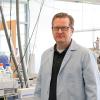Four scientists from the US, Sweden and Switzerland, including an associate professor of civil and environmental engineering at Colorado School of Mines, are calling for improved research into per- and polyfluoroalkyl substances, creating safer alternative chemicals and limiting their use, in a paper published in the journal Environmental Science and Technology. Ian Cousins of Stockholm University leads the team, which includes Mines’ Christopher Higgins, Jamie de Witt of East Carolina University and Zhanyun Wang of ETH Zurich. “A Never-Ending Story of Per- and Polyfluoroalkyl Substances?” was published February 22, 2017.
Ian Cousins of Stockholm University leads the team, which includes Mines’ Christopher Higgins, Jamie de Witt of East Carolina University and Zhanyun Wang of ETH Zurich. “A Never-Ending Story of Per- and Polyfluoroalkyl Substances?” was published February 22, 2017.
PFASs are a large group of man-made chemicals used in a wide variety of products, often to make them more stain-resistant, waterproof or nonstick. The health effects of PFASs in humans are not well understood, but studies have found that animals exposed at high levels resulted in changes in the function of the liver, thyroid and pancreas, and changes in hormone levels.
“More than 3,000 per- and polyfluoroalkyl substances are, or have been, on the global market, yet most research continues to focus on a limited selection of rather well known long-chain PFASs,” the researchers said. “Continuing to overlook the vast majority of other PFASs is a major concern for society.”
According to Higgins and his coauthors, “for most PFASs, there is no comprehensive understanding of their environmental and human exposure routes.” This leads to difficulties in developing proactive, effective strategies for identifying and controlling exposure. The Department of Defense’s Strategic Environmental Research and Development Program recently awarded $1.5 million to Higgins to investigate how PFASs are released, travel and react to other contaminants.
The researchers believe inventing alternatives to PFASs as well as greater regulation of PFAS products is necessary. “We recommend prompt global actions to assess the hazards, exposures and risks associated with the many PFASs on the market, as the basis for effective control measures to limit the production and use of many, if not all, of these substances and their replacement PFASs,” they said.
Given the large number of these substances, the group offers several recommendations for improving the efficiency and effectiveness of research into PFASs. They advocate for:
- devoting more resources to the most critical issues, such as overlooked PFASs and safer alternatives
- creating an inventory of legacy and currently used PFASs
- a focus on understanding the fate and transport of PFASs in the environment
- a focus on understanding the relationships between the structures of PFASs and their properties and behavior
- a focus on understanding PFASs as a group, or several subgroups
- the development of effective control measures, from remediation technologies to safe alternatives
- PFAS science-policy workshops
- chemical manufacturers sharing their information and knowledge to accelerate research by others
- research and development programs that stimulate cooperation between academics, industry and other stakeholders
- sharing of information with developing countries
The researchers said limiting the production and use of most, if not all, PFASs is an option if society wants to play it safe. However, it can be hard to identify alternatives for certain essential uses. “Let us start that dialogue in defining ‘essential’ and ‘non-essential’ uses of PFASs, while simultaneously developing safe alternative substances and processes for those essential uses.”
Contact:
Mark Ramirez, Managing Editor, Communications and Marketing | 303-273-3088 | ramirez@mines.edu
Ashley Spurgeon, Editorial Assistant, Mines magazine | 303-273-3959 | aspurgeon@mines.edu



